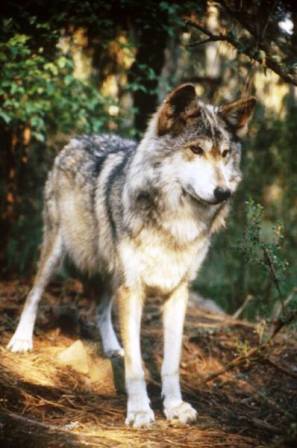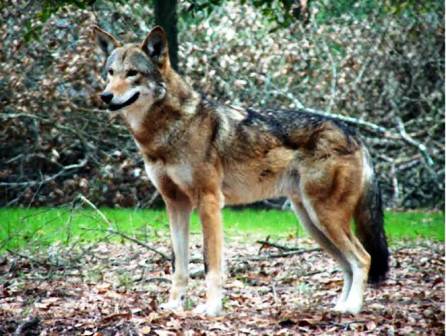Discover Florida Nature
It's time to explore the natural Florida


|
|
|
|
|
 The
red wolf is a smaller and a more slender cousin of the gray wolf. It is
gray-black, with a reddish cast that gives it the color for which it is
named. The red wolf is one of the most endangered animals in the world.
It is a shy species that once roamed throughout the Southeast as a top
predator. Aggressive predator control programs and clearing of forested
habitat combined to cause impacts that brought the red wolf to the brink
of extinction. By 1970, the entire population of red wolves was believed
to be less than 100 animals confined to a small area of coastal Texas
and Louisiana. The
red wolf is a smaller and a more slender cousin of the gray wolf. It is
gray-black, with a reddish cast that gives it the color for which it is
named. The red wolf is one of the most endangered animals in the world.
It is a shy species that once roamed throughout the Southeast as a top
predator. Aggressive predator control programs and clearing of forested
habitat combined to cause impacts that brought the red wolf to the brink
of extinction. By 1970, the entire population of red wolves was believed
to be less than 100 animals confined to a small area of coastal Texas
and Louisiana.The red wolf has a brownish or cinnamon pelt, with grey and black shading on the back and tail. Its muzzle is white furred around the lips. Black specimens are recorded, but these are probably extinct. The red wolf molts once annually every winter. It has large ears which help dissipate heat in the hot and humid climate of the south-eastern United States. The red wolf is generally intermediate in size between the Coyote and the Gray Wolf. Like the Gray Wolf, it has almond-shaped eyes, a broad muzzle and a wide nosepad, though like the coyote, its ears are proportionately larger. The red wolf has a deeper profile, and broader head than the coyote, and has a less prominent ruff than the Gray Wolf. Red wolves are primarily nocturnal (active at night), and communicate by scent marking, vocalizations (including howling), facial expressions and body postures. Shy and secretive, red wolves hunt alone or in small packs, complex social structures that include the breeding adult pair (the alpha male and female) and their offspring. Red wolves tend to form pair-bonds for life. Size of the pack varies with the size of available prey populations. A hierarchy of dominant and subordinate animals within the pack helps it to function as a unit. Dens are often located in hollow trees, stream banks and sand knolls.  The
Red Wolf usually hunts at night, dawn or dusk. It usually feeds alone,
though there is evidence of pack hunting behavior. It is not uncommon
for pack members to partition resources. In south-east Texas, the Red
Wolf primarily feeds on nutria, rabbits,
Hispid
Cotton Rats, Marsh Rice Rats and muskrats. The
reintroduced Red Wolf population of north-eastern North Carolina feeds
primarily on white-tailed deer,
raccoons and rabbits. At
least three livestock depredations have been recorded from this
population. The
Red Wolf usually hunts at night, dawn or dusk. It usually feeds alone,
though there is evidence of pack hunting behavior. It is not uncommon
for pack members to partition resources. In south-east Texas, the Red
Wolf primarily feeds on nutria, rabbits,
Hispid
Cotton Rats, Marsh Rice Rats and muskrats. The
reintroduced Red Wolf population of north-eastern North Carolina feeds
primarily on white-tailed deer,
raccoons and rabbits. At
least three livestock depredations have been recorded from this
population. The red wolf typically reaches sexual maturity at the age of 22 months, though specimens reproducing at the age of 10 months have been recorded. The mating season takes place in February and March, with a gestation period of 61–63 days. Pups are usually born in March-April, and number 1-10 per litter. The breeding pair typically produce one litter annually. Females may establish several dens during the denning season. The pups are often moved from one den to another. The red wolf is now back in the wild, hunting, rearing young, and communicating by its characteristic howl, in several locations in its original southeastern habitats. Since 1987, red wolves have been released into northeastern North Carolina and now roam over more than 560,000 acres that includes three national wildlife refuges, a U.S. Air Force bombing range, and approximately 200,000 acres of private land. Beginning in 1991, red wolves were also released into the 520,000-acre Great Smoky Mountains National Park in eastern Tennessee. Other red wolves have been released on coastal islands in Florida, Mississippi, and South Carolina as a steppingstone between captivity and the wild. Although these islands are not large enough to provide for the needs of more than a few red wolves at a time, they provide the opportunity for them to breed and exist in the wild in order to produce animals for future mainland reintroductions. Since 1988 the Tallahassee Museum has displayed red wolves as a participant in the Red Wolf Species Survival Plan. Threats to the red wolf include habitat loss due to human development, negative attitudes that hinder restoration, severe weather, deaths by motor vehicles, and illegal killings. Interbreeding between coyote and red wolf populations has remained a constant threat to the recovery of this imperiled species. |
|
|
Advertise | Privacy Statement | Dog Encyclopedia | Video |Contact | Alaska Nature |
|